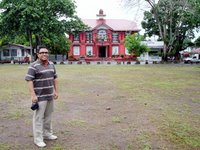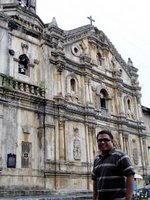This was my second straight year at the Pahiyas festival. Due to the storm which had just left the country, Lucban was covered by a blanket of fog. In fact, for most of the morning, the climate was like that of Baguio. The air was cool but a little more humid than in the summer capital.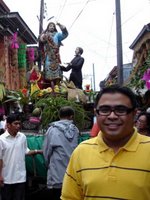 We left the resthouse at 5:45 a.m. by tricycle since we didn't want our van to get stuck in town. For breakfast, it was Lucban longganiza, sinangag and fried egg. Then we joined the procession which left the church at 7:10 a.m. The procession is the best way to view the decorations since it is only the homes and businesses along the procession route which are decorated.The procession route changes every year. And you have to wait several years before you are given the chance to decorate. For one, decorating is very costly and doing it every year will create big dents in one's budget. So the route changes to give residents a chance to join in the festivities once or twice in a decade and a chance to save up and prepare for their next turn.
We left the resthouse at 5:45 a.m. by tricycle since we didn't want our van to get stuck in town. For breakfast, it was Lucban longganiza, sinangag and fried egg. Then we joined the procession which left the church at 7:10 a.m. The procession is the best way to view the decorations since it is only the homes and businesses along the procession route which are decorated.The procession route changes every year. And you have to wait several years before you are given the chance to decorate. For one, decorating is very costly and doing it every year will create big dents in one's budget. So the route changes to give residents a chance to join in the festivities once or twice in a decade and a chance to save up and prepare for their next turn.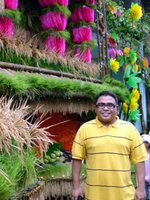 I felt that last year was a bigger celebration than this year. For one, the weather was still unpredictable. And it even rained the night before. Second, the Pahiyas fell on a Sunday last year so the crowds were thicker. I was also disappointed that they used a school band in crew neck t-shirts for the procession. I was charmed by last year's band which was elegant in their traditional band costumes. Oh well!Since I have a previous entry on the Pahiyas and other San Isidro Labrador celebrations, please check it out for detailed information. The photos of the entry are in Friendster so if they blocked Friendster in your school or office, that would explain why the photos don't show up.Anyway, after going around to check out the decors and do some shopping, we went back to the resthouse before lunch to load all our stuff in the van. Our next stop was the neighboring town of Tayabas, the former provincial capital. Just like many Philippine towns and cities, the elegant town of Tayabas was bombed by American forces. Sigh!
I felt that last year was a bigger celebration than this year. For one, the weather was still unpredictable. And it even rained the night before. Second, the Pahiyas fell on a Sunday last year so the crowds were thicker. I was also disappointed that they used a school band in crew neck t-shirts for the procession. I was charmed by last year's band which was elegant in their traditional band costumes. Oh well!Since I have a previous entry on the Pahiyas and other San Isidro Labrador celebrations, please check it out for detailed information. The photos of the entry are in Friendster so if they blocked Friendster in your school or office, that would explain why the photos don't show up.Anyway, after going around to check out the decors and do some shopping, we went back to the resthouse before lunch to load all our stuff in the van. Our next stop was the neighboring town of Tayabas, the former provincial capital. Just like many Philippine towns and cities, the elegant town of Tayabas was bombed by American forces. Sigh!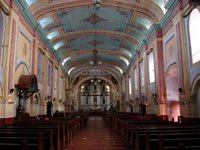 The town lost all of its grand mansions in the poblacion. I was told that the Americans were targeting the church but for some reason, the bombs missed. And thank God they did since it would have been such a tragedy if American bombs destroyed this national cultural treasure!
The town lost all of its grand mansions in the poblacion. I was told that the Americans were targeting the church but for some reason, the bombs missed. And thank God they did since it would have been such a tragedy if American bombs destroyed this national cultural treasure!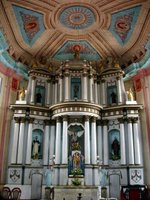 The Minor Basilica of St. Michael and the nearby Casa Communidad de Tayabas is all that remains of this once grand town. Sigh! I wonder how many grand old towns and cities the American forces carpet bombed during the Second World War.We were lucky since Dr. Leticia Yap was in town. Dr. Yap is a native of Tayabas but lived most of her life in San Fernando since her husband is from there. She was at one time a provincial board member of Pampanga. Anyway, we joined her for lunch at their home. After the sumptuous lunch, we were off to Sariaya to view the old houses.For some reason, Sariaya was better the first time I visited last year. The mayor built a big eyesore, a multi-purpose hall, in a very elegant art deco town plaza. They could have at least made sure that the architecture of this new structure matched the flamboyance of its surroundings.
The Minor Basilica of St. Michael and the nearby Casa Communidad de Tayabas is all that remains of this once grand town. Sigh! I wonder how many grand old towns and cities the American forces carpet bombed during the Second World War.We were lucky since Dr. Leticia Yap was in town. Dr. Yap is a native of Tayabas but lived most of her life in San Fernando since her husband is from there. She was at one time a provincial board member of Pampanga. Anyway, we joined her for lunch at their home. After the sumptuous lunch, we were off to Sariaya to view the old houses.For some reason, Sariaya was better the first time I visited last year. The mayor built a big eyesore, a multi-purpose hall, in a very elegant art deco town plaza. They could have at least made sure that the architecture of this new structure matched the flamboyance of its surroundings. But there was an obvious change with the colors of the municipio. From a plain white facade, the current colors exude the art deco flair. I know it has elicited mixed reactions but if you want to be historically accurate, you will have to follow color schemes of the period, no matter how flashy they are. Again, a detailed account is in last year's entry.After a short walking tour, it was back to Tayabas to witness the hagisan ng suman. For a Monday, I was shocked to see that there were double or even triple the number of participants in the procession. Was this a sign of trying times? Because last year, I could still stand behind the anda of San Isidro Labrador. But this year it was a mad rush for the suman flying in the air in the thousands. And I didn't want to suffer a Wowowee!
But there was an obvious change with the colors of the municipio. From a plain white facade, the current colors exude the art deco flair. I know it has elicited mixed reactions but if you want to be historically accurate, you will have to follow color schemes of the period, no matter how flashy they are. Again, a detailed account is in last year's entry.After a short walking tour, it was back to Tayabas to witness the hagisan ng suman. For a Monday, I was shocked to see that there were double or even triple the number of participants in the procession. Was this a sign of trying times? Because last year, I could still stand behind the anda of San Isidro Labrador. But this year it was a mad rush for the suman flying in the air in the thousands. And I didn't want to suffer a Wowowee! simply to take photos in the middle of the rushing crowd. Hehe!
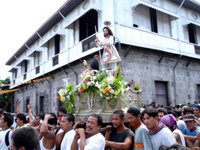 But from the sidelines, this practice was so intriguing and definitely worth watching! I wonder if there have been any studies made on this and similar religious practices such as the Nazareno procession in Quiapo; why people would risk their lives driven by an ounce of faith, and in the case of Tayabas, a possible windfall of suman.From Tayabas, we motored back to Lucban and then to Majayjay to visit the old church which is also a national cultural treasure. Driving along the mountain roads offered magnificent views of the slopes of Mount Banahaw and the numerous streams which flowed from it. Looking up at the towering fortress-like Church of San Gregorio Magno was just awe-inspiring. I could just imagine how it looked when there were just a few houses and forests all around it.
But from the sidelines, this practice was so intriguing and definitely worth watching! I wonder if there have been any studies made on this and similar religious practices such as the Nazareno procession in Quiapo; why people would risk their lives driven by an ounce of faith, and in the case of Tayabas, a possible windfall of suman.From Tayabas, we motored back to Lucban and then to Majayjay to visit the old church which is also a national cultural treasure. Driving along the mountain roads offered magnificent views of the slopes of Mount Banahaw and the numerous streams which flowed from it. Looking up at the towering fortress-like Church of San Gregorio Magno was just awe-inspiring. I could just imagine how it looked when there were just a few houses and forests all around it.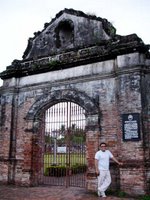 We then proceeded to the Nagcarlan Underground Cemetery but it was closed when we got there. At the gate was a sign which said that due to the government's energy conservation program, the cemetery was open only from Tuesday to Saturday. Hello? I could understand Monday but to close it on a Sunday, that is ridiculous!Anyway, after a few photos, it was back to Manila. What a day! More photos in My Heritage Photos. Click on Laguna and Quezon.
We then proceeded to the Nagcarlan Underground Cemetery but it was closed when we got there. At the gate was a sign which said that due to the government's energy conservation program, the cemetery was open only from Tuesday to Saturday. Hello? I could understand Monday but to close it on a Sunday, that is ridiculous!Anyway, after a few photos, it was back to Manila. What a day! More photos in My Heritage Photos. Click on Laguna and Quezon.
















